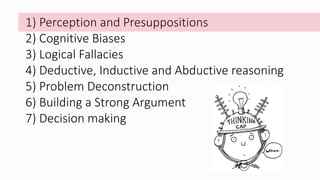
Critical thinking 1_perceptionspresuppositions
- 1. 1) Perception and Presuppositions 2) Cognitive Biases 3) Logical Fallacies 4) Deductive, Inductive and Abductive reasoning 5) Problem Deconstruction 6) Building a Strong Argument 7) Decision making
- 2. Perception And Presuppositions Meetup Workshop – Diana & Karina Critical Thinking for IT
- 3. “We don’t see things as they are, we see them as we are.” – Anais Nin
- 4. 4 Can we increase our Perception? To become better problem solvers, when it comes to taking a decision in a non deceived manner. Why would we want to increase our perception? All you need is some will power and an open mind, which permits you to think outside the box. What do you need to change your perception? You will start to understand others‘ reasons and actions and this will give you a more objective image of reality. What if the enhancement of your perception will make you get rid of some frustrations? You can increase your perception by using Critical Thinking and becoming more aware of your thinking patterns. How do you actually increase your perception?
- 5. 5 How to define Perception THE PERCEPTUAL PROCESS Is the process by which people translate sensory impressions into a coherent and unified view of the world around them … After the internal and external stimuli are received the selection comes into place, followed by the organization of these stimuli and their interpretation, converting everything into a response. INFORMATION Selecting stimuli External factors: location, size, contrast Internal factors: needs, interest, learning Organizing Figure background, perpetual organization (perceptual grouping) Interpreting Attribution, Projection, Stereotyping Response Attitude, motivation, feeling
- 6. 6 Factors that influence PERCEPTION Target/Object: novelty, motion, sound, size, background, proximity, similarity Perceiver: attitudes, motives, interests, expectations, personal experience, self-concept Situation/Context: time, work setting, social setting
- 7. 7 PERCEPTUAL Grouping THE NEED OF PATTERN RECOGNITION Bad Team Good Team
- 8. 8 PERCEPTUAL Grouping THE NEED OF PATTERN RECOGNITION Proximity: things that are near each other seem to be grouped together Enclosure: areas surrounded by a barrier give a sense of grouping Similarity: similar things tend to appear grouped together Closure: the law of closure tells us that forms are grouped together if they seem to define an entity Continuity: points connected by straight or curving lines are seen in a way that follows the smoothest path Connection: shapes are linked one to another and give the impression of continuity Bad Team Good Team
- 9. ATTRIBUTION Theory HOW CAN WE EXPLAIN THE CAUSE OF A BEHAVIOUR? Dispositional (internal cause) vs Situational (external cause) Attribution When we decipher behavior, we take into account 3 kinds of evidence: Distinctiveness: If Tom only laughs at this comedian, the distinctiveness is high. If Tom laughs at everything, then distinctiveness is low. Consistency: If Tom always laughs at this comedian the consistency is high. If Tom rarely laughs at this comedian, then consistency is low. Consensus: If everybody in the audience is laughing, the consensus is high. If only Tom is laughing consensus is low.
- 10. 10 Shortcuts in judging OTHERS Selective Perception: People selectively interpret what they see on the basis of their interests, background, experience and attitudes. Halo Effect: Drawing a general impression about an individual on the basis of a single characteristic. Contrast Effect: Evaluation of a person’s characteristics that are affected by comparison with other people recently encountered who rank higher or lower on the same characteristics. Projection: Attributing one’s own characteristics to other people. Stereotyping: Judging someone on the basis of one’s perception of the group to which that person belongs. 13% 87% The British Science Association made a study on how many individuals judge their colleagues at work.
- 11. “There are things known and there are things unknown, and in between are the doors of perception.” – Aldous Huxley
- 12. Practical application for awareness https://www.youtube.com/watch?v=ubNF9QNEQLA
- 13. 13 WORKING ON Presuppositions Working on Presuppositions to improve Perception A presupposition is a thing tacitly assumed beforehand at the beginning of a line of argument or course of action.
- 14. Question 1 of 5 Where does this road end? 1.Presupposes nothing. 2.Presupposes there is a road and it has an end. 3.Presupposes I am familiar with this road. 4.Presupposes that all roads have end-points.
- 15. Question 2 of 5 When do I get to see the money? 1.Presupposes that there is money. 2.Presupposes that I can see. 3.Both 1 and 2. 4.Neither 1 nor 2.
- 16. Question 3 of 5 How can I replace a flat tire? 1.Presupposes that there is a flat tire. 2.Presupposes that this is an appropriate or reasonable question in the context. 3.Presupposes that there is a spare tire. 4.None of the above.
- 17. Question 4 of 5 Should Fred take math? 1.Presupposes nothing. 2.Presupposes that Fred wants to take a class. 3.Presupposes Fred can enroll in a math class. 4.Both 2 and 3.
- 18. Question 5 of 5 Which of you likes pizza? 1.Presupposes some of us like pizza. 2.Presupposes that pizza exists (i.e., that there is a food called pizza). 3.Presupposes that at least some of us know what pizza is (i.e. presupposes that some of us have eaten pizza before). 4.All the above.
Editor's Notes
- We are always confronted with stressful situations at work. Can we reduce their occurrence by increasing our perception?